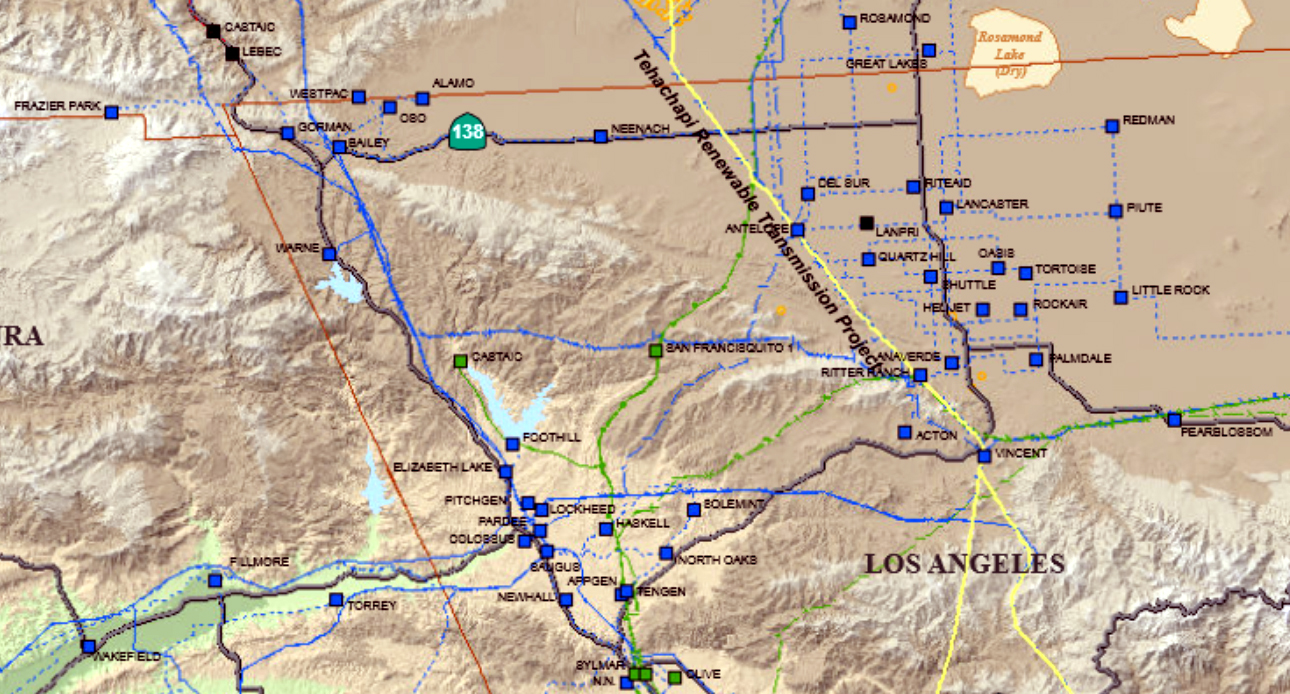|
|
Elizabeth Lake, California
|
October 2011 — Pacific Light and Power Co. (later Southern California Edison) switching station at Elizabeth Lake. Photos by Elizabeth Lake resident Judy Baker-Griffus, whose husband Paul Griffus, a painting contractor (Griffco Painting), painted the property owner's house. The owner gave the couple a tour of the switching facility. They were unable to access the top of it due to safety concerns.
This Pacific Light and Power Co. switching station was built circa 1911 at what is now 14140 Elizabeth Lake Road, just south of Firtree Road in Lake Hughes. It is identified in the Edison photo collection at the Huntington Library as "Lake Power Station," where "lake" refers to nearby Lake Elizabeth. Pacific Light and Power Co. was organized in 1902 by Los Angeles real estate magnate Henry E. Huntington, who had formed the Pacific Electric Railway (L.A.'s Red Car system) a year earlier. Huntington (1850-1927) was a nephew of railroad tycoon Collis P. Huntington and held executive positions in his uncle's companies. Before the Los Angeles Department of Water and Power became L.A.'s sole electricity service provider — which didn't happen until 1939 — it was a free-for-all as entrepreneurs competed to electrify the city beginning in 1882 with a forerunner of PG&E. Streetcars became popular modes of conveyance, and competition was fierce. Henry Huntington purchased the narrow-gauge Los Angeles Railway (the Yellow Car system) in 1898 and then, after uncle Collis' death in 1900, set out to compete with the Southern Pacific for lucrative rail service to the distant suburbs with standard-gauge streetcars that were more versatile and ubiquitous than passenger trains. Huntington and others would need to develop new sources of electricity to fuel the growth. Light rail was consuming 80 percent of the city's power by the early 1900s. Huntington set up Pacific Light and Power Co. to provide steam-generated (thermal) electricity to his Red Car system and in 1907 built the company's first major power plant in Redondo Beach. But thermal power was expensive. Hydroelectricity was cheaper, so in 1911 Huntington started construction on hydroelectric plants on the San Joaquin River at Big Creek, both to power the streetcars and to serve other electricity customers in Los Angeles. (Simultaneously in 1911, the Bureau of Los Angeles Aqueduct Power started construction on Power House No. 1 in San Francisquito Canyon.) In 1913, Pacific Light and Electric Co. shuttered its Redondo Beach plant after a mishap and began using Big Creek. The 240-mile transmission line was one of the world's longest. From photographs, we see that Pacific Light and Power Co. also must have built a hydroelectric plant on the Kern River at the same time it was developing Big Creek, because photos identify a power station in Castaic — apparently on the grounds of the current Pitchess Detention Center[1] — as being on the "B.C." (Big Creek) line, while this station at Elizabeth Lake is identified as being on the Kern transmission line. Photos identify the Castaic station as "new" in 1910 and the Elizabeth Lake station as "new" in 1911. A modern (2014) map from the California Energy Commission appears to show both (obsolete) lines in green; see below. World War I saw a consolidation of L.A.'s power interests as fuel costs rose. In 1917 (the same year L.A.'s Power House No. 1 went online), Huntington sold Pacific Light and Power Co. to a rival company which had formed in 1897 and in 1909 changed its name to Southern California Edison. Over the next two decades, L.A.'s three major electric utilities would negotiate for territory — L.A. Bureau of Power and Light (later part of DWP); Los Angeles Gas and Electric (purchased by L.A. Power and Light in 1937); and Southern California Edison, which ended up with all unincorporated territories in Los Angeles County and all cities except Los Angeles, Pasadena, Glendale and Burbank. 1. Per LASD Sgt. Gerri Davis McCorkle, Pitchess Detention Center, 2014: Edison asserts a right-of-way through the county property which records show as being associated with H.E. Huntington.
19200 dpi jpegs from digital images by Judy Baker-Griffus. |
The site owner makes no assertions as to ownership of any original copyrights to digitized images. However, these images are intended for Personal or Research use only. Any other kind of use, including but not limited to commercial or scholarly publication in any medium or format, public exhibition, or use online or in a web site, may be subject to additional restrictions including but not limited to the copyrights held by parties other than the site owner. USERS ARE SOLELY RESPONSIBLE for determining the existence of such rights and for obtaining any permissions and/or paying associated fees necessary for the proposed use.




